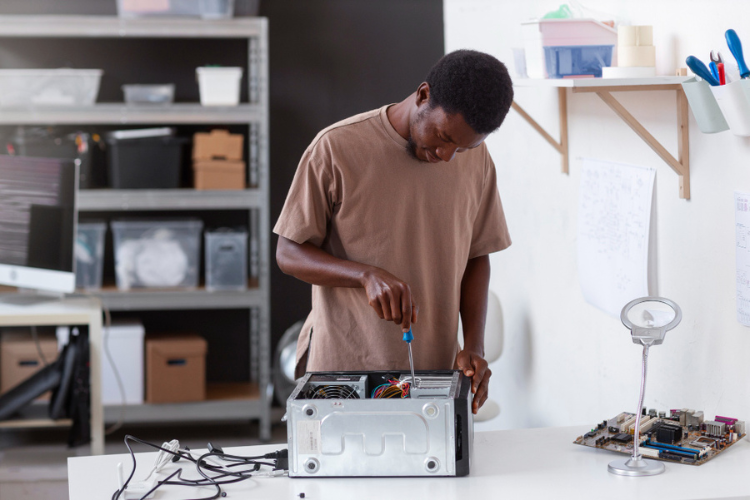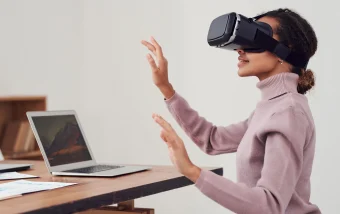Real Estate Link Building That Actually Works: Earn Local Authority, Rankings, and Better Leads Without Spam
Dec 10, 2025

Dec 10, 2025

Dec 10, 2025

Dec 09, 2025

Dec 09, 2025

Dec 05, 2025

Dec 05, 2025

Dec 04, 2025

Dec 04, 2025
Sorry, but nothing matched your search "". Please try again with some different keywords.


Look. Your laptop alone won’t cut it anymore. You’re grinding 10-hour days.
Your neck hurts. Your wrist aches. And you’re switching between seven tabs just to send one email.
This is the reality for most Kenyan professionals. But here’s what nobody tells you: the computer accessories Kenya you use matter more than the laptop you buy.
I’ve seen people drop 80K on a laptop, then work on it with the built-in trackpad and keyboard. That’s like buying a Mercedes and putting bicycle tires on it.
Before we dive in, let’s talk about where to get these accessories in Kenya. You need a supplier who understands the local market and won’t leave you hanging when something breaks.
Computer accessories in Kenya from Minify Solutions give you exactly that. Real warranties. Real support. No surprises.
Think about it this way: you’re about to invest in tools that will touch your hands thousands of times per week. Get the right ones now or pay with pain later.
Take notes of the important computer accessories for professionals.
Here’s a number that should wake you up. Jon Peddie Research tracked dual monitor users over 15 years. The result? 42% productivity increase on average.
That means if you’re billing clients at 5K per hour, you just made an extra 2,100 per hour by adding one screen. The math isn’t even close.
Why external monitors work:
You stop playing tab roulette with your work. Your email sits on one screen while your actual work lives on the other. No more minimizing and maximizing windows fifty times an hour.
Dell’s research showed something even more interesting.
People using a 24-inch external monitor completed tasks 32% faster than those hunched over a 14-inch laptop screen. Bigger screens mean you see more context without constantly scrolling.
What to look for in an external monitor for Kenya:
And here’s the kicker. You don’t need to break the bank. A quality 24-inch monitor costs less than a month of eating lunch out. The ROI hits in week one.
For Kenyan professionals working from home or juggling multiple clients, an external monitor isn’t a luxury. It’s the difference between finishing at 6 pm or 9 pm.
Repetitive Strain Injury sounds boring until you have it. Then it’s the only thing you think about.
Your standard keyboard and mouse force your wrists into unnatural positions. Hour after hour. Day after day. Until one morning you wake up and your wrist feels like it’s on fire.
The real cost of bad peripherals:
Most people ignore the early warning signs. A little ache here. Some tingling there. By the time they take it seriously, they’re looking at weeks of recovery and expensive physiotherapy.
Ergonomic keyboards change the game:
Split keyboards let you position each half shoulder-width apart. Your shoulders relax. Your wrists stay straight. The constant tension in your forearms disappears.
Microsoft and Logitech make solid ergonomic keyboards that work right out of the box. No learning curve. Just instant relief.
Vertical mice are non-negotiable:
A traditional mouse twists your forearm into an unnatural position. Your ulna and radius bones cross over each other. This creates friction and inflammation over time.
A vertical mouse keeps your hand in a handshake position. Natural. Comfortable. Sustainable for 8-hour work days.
Here’s what most people get wrong: they buy an ergonomic mouse but keep their keyboard in the same spot. Then they wonder why their shoulder hurts from reaching sideways all day.
The setup that actually works:
Many Kenyan professionals work from makeshift home offices. You might not have a fancy desk, but you can still protect your body. A raised platform for your laptop plus an external keyboard and mouse beats any expensive chair.
Laptops are designed for mobility, not marathon work sessions. Yet here we are, bent over them for 10 hours straight.
The problem is simple. When you look at your laptop screen, you’re looking down. Your neck bends forward. Every degree your head tilts forward adds 10 pounds of pressure on your spine.
At 45 degrees (the typical laptop viewing angle), you’re adding 50 pounds of stress. All day. Every day.
What a laptop stand does:
Raises your screen to eye level. Your neck stays neutral. Your spine stays aligned. That tension headache at 3pm? Gone.
You don’t need some expensive aluminum stand. A simple adjustable stand works fine. Just make sure it’s stable and raises your screen 5-6 inches off the desk.
The complete laptop setup:
This setup transforms any desk into a proper workstation. Dining table. Coffee shop counter. Your bed (though I don’t recommend it).
One caveat: if you move around a lot, carrying a stand might not work. In that case, just elevate your laptop with books or whatever’s handy. Even 2-3 inches makes a difference.
Modern laptops are beautiful.
And completely useless for actual work because they have two USB-C ports and nothing else.
You need to connect your mouse, keyboard, external drive, phone charger, and HDMI cable. But you can’t because your laptop was designed by people who apparently never use computers.
Enter the USB hub:
One cable into your laptop. Seven or eight ports out. Problem solved.
What to look for in a USB hub for Kenya:
A good USB hub turns your laptop into a proper workstation. You walk up to your desk. Plug in one cable. Everything connects. Monitor. Mouse. Keyboard. Internet. Phone charger.
When you leave, you unplug one cable. No fumbling with six different connections.
This might seem trivial until you realize you’re saving 3-4 minutes every time you sit down or pack up. Over a month, that’s hours. Over a year, that’s days.
You just spent 60K on a laptop. Don’t carry it in a plastic bag from Naivas.
Nairobi traffic is brutal. Matatus are cramped. Your backpack gets thrown around.
One good bump and your screen cracks. Or worse, your hard drive dies and takes three months of work with it.
What makes a good laptop bag:
HP and Lenovo make solid laptop bags. Dell too. They’re built specifically for their laptop sizes, which means a snug fit.
Or go for a universal padded sleeve inside your regular bag. Cheaper option. Same protection.
Here’s what nobody tells you: the bag matters as much for organization as protection. A good bag has dedicated pockets for your charger, mouse, cables, and documents. You’re not digging around for 30 seconds every time you need something.
For Kenyan professionals who move between client meetings, co-working spaces, and home offices, a quality laptop bag is your mobile office. Treat it that way.
Your laptop will die. Not if. When.
Hard drives fail. Laptops get stolen. Coffee spills. Power surges.
Additionally, if your only copy of your work lives on your laptop, you’re gambling with your career.
The backup rule that saves careers:
3-2-1 backup strategy. 3 copies of your data. 2 different storage types. 1 copy off-site.
In practical terms, for Kenyan professionals:
External SSD vs Hard Drive:
Traditional external hard drives are cheap. 1TB for around 5-7K. But they’re slow and fragile.
External SSDs cost more (around 10-15K for 1TB). But they’re 5x faster and shock-resistant. You drop a hard drive, you cry. You drop an SSD, it probably survives.
For most people, start with a 1TB external SSD. Back up your work every Friday. Takes 20 minutes. It could save your entire business.
Cloud storage considerations:
The internet in Kenya can be unpredictable. Uploading 50GB to the cloud might take all day. That’s why local backup (external drive) plus cloud backup works best.
Use cloud storage for your most critical files. Use external drive for everything else.
Zoom calls with echo. Client meetings where nobody can hear you. That one guy whose audio sounds like he’s underwater.
Don’t be that person.
Your laptop’s built-in microphone picks up everything. Additionally, your keyboard clicks. Your neighbor’s dog. The matatu outside.
What a quality headset does:
Moreover, Noise cancellation filters out background noise. Your voice comes through clearly. People can actually understand you.
Wireless Bluetooth headsets offer freedom to move around, but battery life can be an issue.
Wired USB headsets are reliable, require no charging, and are perfect for long workdays. Over-ear vs on-ear: Over-ear is more comfortable for hours-long meetings.
Logitech, Jabra, and Plantronics make professional-grade headsets that last. You’re looking at 5K-15K, depending on features.
For remote workers and professionals taking client calls, your headset is your voice. Cheap earbuds from the supermarket won’t cut it.
Pro Move:
Get a headset with a mute button on the cable or earpiece. You can quickly mute when your dog barks or someone walks into your room. Small thing. Massive difference in professional meetings.
Let’s talk about power surges. They happen. Often. And they fry electronics.
A power surge can destroy your laptop, monitor, and external drive in one second. All that money. All that work. Gone.
How surge protectors work:
They absorb excess voltage. Your equipment gets clean, stable power. When a surge hits, the protector takes the hit instead of your laptop.
What to look for:
A good surge protector costs 2-3K. Your laptop costs 60K+. Your external monitor costs 20K+. The math is obvious.
The reality in Nairobi:
Power fluctuations happen regularly, especially during the rainy season. One surge can kill your entire setup.
Invest in protection now or buy new equipment later. Your choice.
This one seems minor until you actually fix it. Then you realize how much mental energy you were wasting.
Tangled cables. Cables falling behind your desk. Hunting for the right cable every time you need to charge something.
5 minutes of setup saves you 5 minutes per day. Over a year, that’s 30 hours.
More importantly, a clean desk reduces mental clutter. You can focus on work instead of navigating a cable maze.
You have three options:
The smart move? Work with established suppliers like Minify, who understand the Kenyan market. When something breaks (and it will), you need someone local to handle it.
Your computer setup either supports your success or slowly destroys your body. There’s no middle ground.
Most Kenyan professionals I meet are suffering unnecessarily. Neck pain. Wrist pain. Eye strain. All because they’re trying to save money on accessories while spending thousands on Netflix and lunch.
The accessories in this guide aren’t luxuries. They’re tools that multiply your output while protecting your health.
Start with the essentials. External monitor. Ergonomic keyboard and mouse. Proper backup system.
Add the rest as you grow.
Your future self (with a healthy back and wrists that don’t ache) will thank you.
Get started today. Your productivity and health are worth it.
Barsha is a seasoned digital marketing writer with a focus on SEO, content marketing, and conversion-driven copy. With 7 years of experience in crafting high-performing content for startups, agencies, and established brands, Barsha brings strategic insight and storytelling together to drive online growth. When not writing, Barsha spends time obsessing over conspiracy theories, the latest Google algorithm changes, and content trends.
View all Posts
Real Estate Link Building That Actually Works...
Dec 10, 2025
Why Health-Conscious Consumers Choose Blockch...
Dec 10, 2025
How To Buy Xupikobzo987Model? Decoding The Mo...
Dec 09, 2025
Workplace Management EWMagWork: Is This Smar...
Dec 09, 2025
Social Media Stuff EmbedTree: Is This Digita...
Dec 05, 2025

